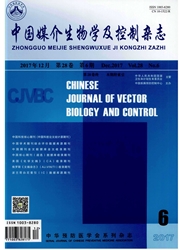

 中文摘要:
中文摘要:
目的 检测安徽省芜湖地区家庭空调隔尘网灰尘和空调开机前、后室内空气中粉尘螨Ⅰ类过敏原(Derf 1)和屋尘螨Ⅰ类过敏原(Der p 1)浓度,以探讨隔尘网中尘螨过敏原与哮喘发病的关系.方法 分别从哮喘患者和健康居民家庭采集空调隔尘网灰尘样本各30份,同时用粉尘采样器采集哮喘患者和健康居民室内空气粉尘样本,开机前、后各采集30份.ELISA法检测Derf1、Derp 1的浓度,Dot-ELISA检测灰尘提取液过敏原性.结果 健康人群(家庭)组隔尘网灰尘中的过敏原Derf1、Derp 1浓度中位数分别为1.49和1.28 μg/g;哮喘患者(家庭)组隔尘网灰尘中的过敏原Derf1、Derp 1浓度中位数分别为0.73和0.85 μg/g,二者差异有统计学意义(分别为P<0.01,P<0.05).健康人群(家庭)组的空调开机前空气中Derf1、Derp 1浓度中位数分别为4.65和5.90 ng/m3,开机后分别为7.65和7.35 ng/m3.哮喘患者(家庭)组空调开机前空气中Derf1、Derp 1浓度中位数分别为5.05和5.90 ng/m3,开机后分别为7.15和7.10 ng/m3.检测结果显示,打开空调送风情况下,哮喘患者(家庭)组与健康人群(家庭)组的空气中Derf1、Der p 1浓度均比未开空调时高,且差异有统计学意义(P<0.05).Dot-ELISA分析显示,灰尘提取液中过敏原能与螨过敏性哮喘患者的IgE产生结合反应.结论 芜湖地区居民空调隔尘网中含有尘螨Ⅰ类过敏原,空调开启送风后空气中尘螨的2个主要过敏原浓度均显著升高,应重视家用空调的清洁与净化,定期清洗、更换隔尘网以防止或减少尘螨孳生.
 英文摘要:
英文摘要:
Objective To determine the concentrations of allergens Der f 1 (from Dermatophagoides farinae) and Der p 1 (from D. pteronyssinus) in the dust from filters of domestic air conditioners and in the indoor air before and after the operation of air conditioners in Wuhu, Anhui province, China and to investigate the association of dust mite allergens in air conditioner fihers with asthma attack. Methods Sixty dust samples were equally collected from the air conditioner filters in domestic houses of asthmatic patients and healthy subjects; indoor air dust samples were collected from the rooms of the above two groups using dust samplers, and for each group, 30 samples were collected before the operation of air conditioners and 30 samples after the operation. The concentrations of allergens Der f 1 and Der p 1 were determined by enzyme-linked immunosorbent assay (ELISA), and the binding capacity of allergens from dust extract was measured by dot-ELISA. Results The median concentrations of Der f 1 and Der p 1 in dust from filters were 1.49 and 1.28 μg/g for healthy subjects, versus 0.73 and 0.85 μg/g for asthmatic patients (P〈0.01 and P〈0.05). The median concentrations of Der f 1 and Der p 1 in air before the operation of conditioners were 4.65 and 5.90 ng/m3 for healthy subjects, versus 5.05 and 5.90 ng/m3 for asthmatic patients; the median concentrations of Der f 1 and Der p 1 in air after the operation of conditioners were 7.65 and 7.35 ng/m3 for healthy subjects, versus 7.15 and 7.10 ng/m^3 for asthmatic patients. The results showed that for both asthmatic patients and healthy subjects, the concentrations of Der f 1 and Der p 1 in air increased significantly after the air conditioners were turned on (P〈0.05). Additionally, the Dot-ELISA findings revealed that the allergens from dust extract were capable of binding to IgE from the sera of asthmatic patients allergic to dust mites. Conclusion Allergens Der f 1 and Der p 1 exist in the filters of air conditioners in domestic houses of Wuhu, and
 同期刊论文项目
同期刊论文项目
 同项目期刊论文
同项目期刊论文
 Morphologic features of Sancassania berlesei (Acari: Astigmata: Acaridae), a common mite of stored p
Morphologic features of Sancassania berlesei (Acari: Astigmata: Acaridae), a common mite of stored p Genetic diversity and differentiation of Lepidoglyphus destructor (Acari: Glycyphagidae) inferred fr
Genetic diversity and differentiation of Lepidoglyphus destructor (Acari: Glycyphagidae) inferred fr Production of a chimeric allergen derived from the major allergen group 1 of house dust mite species
Production of a chimeric allergen derived from the major allergen group 1 of house dust mite species Generation of a chimeric dust mite hypoallergen using DNA shuffling for application in allergen-spec
Generation of a chimeric dust mite hypoallergen using DNA shuffling for application in allergen-spec 期刊信息
期刊信息
